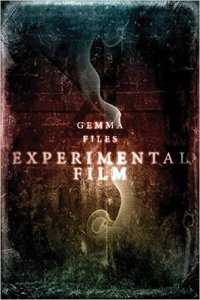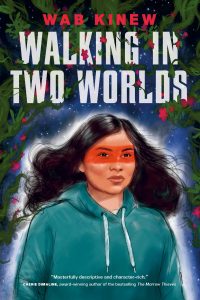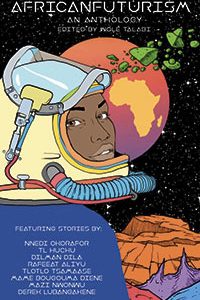John Langan reviews Gemma Files
Experimental Film, Gemma Files (ChiZine 978-1771-48349-0, $16.99, 305pp, tp) December 2015.
 There’s a cache of lost films at the center of Experimental Film, the fine, compelling novel by Gemma Files. The movies were made in the early years of the 20th century by a woman who herself went missing during what should have been a routine train journey to Toronto. Shot on highly unstable silver nitrate stock, the short films are variations on the same subject: a mysterious, veiled woman, her dress ornamented with beads or mirrors that make her flash and shimmer. She moves through a stylized farm landscape, bending to speak to a child laborer, when it becomes apparent that she is holding a sword in one hand.
There’s a cache of lost films at the center of Experimental Film, the fine, compelling novel by Gemma Files. The movies were made in the early years of the 20th century by a woman who herself went missing during what should have been a routine train journey to Toronto. Shot on highly unstable silver nitrate stock, the short films are variations on the same subject: a mysterious, veiled woman, her dress ornamented with beads or mirrors that make her flash and shimmer. She moves through a stylized farm landscape, bending to speak to a child laborer, when it becomes apparent that she is holding a sword in one hand.
Lois Cairns, the narrator-protagonist of the novel, first becomes aware of Iris Dunlopp Whitcomb’s work at a screening of new independent Canadian films she is covering for a film publication. One of the filmmakers includes an excerpt from one of the lost movies in his Untitled 13. The result affects Lois profoundly, viscerally, leading her to interview Wrob Barney about the footage he’s sampled. That conversation sets Lois on the path of investigating Iris Whitcomb’s life and art. A film historian as well as critic, Lois immediately understands the earthshaking implications of the lost movies for the history of women in film, especially women who produced and directed their own work. She contacts a former student of hers, Safie Hewsen, now a budding filmmaker, and enlists her in documenting the search for Iris Whitcomb’s films.
It isn’t very long, however, before a series of escalatingly strange and unnerving events connected to her inquiry cause Lois to realize that there might be more to the missing movies than she anticipated. Her research reveals that the subject of Iris Whitcomb’s films is a minor deity from Wendish mythology, Lady Midday, who interrogates farm laborers to learn if they are performing their work well and whole-heartedly. Gradually, Lois understands that what she at first took for dramatizations of a somewhat esoteric folk tale are in fact recreating encounters with an actual supernatural entity. What’s more, Lady Midday has become entangled with Iris Whitcomb’s work – especially the last piece she shot – to the extent that it can provide her a means to return in force to a world whose steady forgetting of her has reduced the deity to a fraction of her former strength.
The story of the forbidden text is, of course, a mainstay of horror fiction, from Lovecraft’s Necronomicon to Barron’s Black Guide. The number of works that have made movies their sinister texts is more select, but includes Ramsey Campbell’s Ancient Images and Marissa Pessl’s Night Film, as well as “each thing i show you is a piece of my death”, the story Files co-wrote with her husband, Stephen Barringer, and which served as something of a dry run for Experimental Film. Where this novel succeeds is in its understanding of film, from the process by which it is made to those by which it is disseminated and discussed; from its history to its culture. Lois Cairns is steeped in movies, and she incorporates her understanding into her narrative, pausing to deliver relevant information when necessary. Lois is a self-conscious narrator, always aware of how she’s framing the story she’s recounting, and including the reader in her strategizing. The result is an experimental novel about her quest for a set of films whose experimental qualities extend far beyond her expectations.
All of this would be impressive enough, but Files gives the story additional weight through her description of Lois’s experience as the mother of an autistic child. From the early pages of the novel, Files shows the challenges Lois confronts in her son, Clark, whose autism causes him to speak mostly in quotations from popular media, and who cannot communicate with Lois and Simon, her husband and Clark’s father, as fully as any of them would like. Lois is unsparing about the trials of raising her son, but she leavens her bluntness with enough wit and warmth to bring her love for her son to complicated life. Clark’s occasional distance from Lois, her remove from her idea of a stereotypical mother, expand the novel’s concern with the lost, with what is missing, and give it an added poignancy.
At the same time, the novel’s evocation of Toronto and the community of its filmmakers and critics results in a vivid sense of place. Details about the city’s geography combine with anecdotes about the men and women who populate its film culture to create a setting that is an integral part of the narrative. Experimental Film could not happen in any other place and be the same novel; this is very much a Canadian book, concerned with the history and current state of Canadian filmmaking.
The recent republication of Gemma Files’s first two collections of short fiction, Kissing Carrion and The Worm in Every Heart, was a reminder of how long and how well she has been writing. The last several years have seen a welcome uptick in her output, from the cosmic horror horse opera of the Hexslinger series to the story cycle that comprises We Will All Go Down Together, not to mention, her stories in any number of anthologies. Experimental Film represents the next, significant contribution to what is emerging as one of the most interesting and exciting bodies of work currently being produced in the horror field. Every film, Lois Cairns writes, is an experiment. The same might be said of every novel. This one succeeds, wildly.





